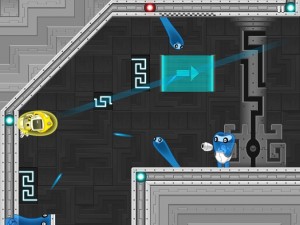(Editor’s Note: What follows is the original review written for the first version the author played, and our site score also reflects the state of the game at that time. Since then, one or more critiques have been addressed by the developer. For a list of these, see “Addendums” below the original verdict at the end of the article.)
One of the June releases we’ve been anticipating most is Demergo Studios’ function.repair (Out Now, $0.99 Release Sale), which appeared set to redefine platforming in a way perfectly suited to the touchscreen. It delivers handily as far as core gameplay is concerned, but disaster strikes from an unexpected direction just when the player will be getting ready to hail it as a watershed moment in iOS gaming. It may still go down in history that way, but only if it gets some emergency repairs, pronto.
 First, let me talk about what function.repair does right. As we explained in our hands-on preview a few weeks back, you assume the role of Fixbot, suddenly awakened with the task of repairing a heavily damaged spaceship. While the mystery of how the ship ended up needing such extensive repairs is a consistent motivator, the real star of the show is Fixbot’s wall-to-wall locomotion.
First, let me talk about what function.repair does right. As we explained in our hands-on preview a few weeks back, you assume the role of Fixbot, suddenly awakened with the task of repairing a heavily damaged spaceship. While the mystery of how the ship ended up needing such extensive repairs is a consistent motivator, the real star of the show is Fixbot’s wall-to-wall locomotion.
It was an ingenious design decision; regardless of your gaming background up to now you’ll feel like you’re learning the ropes again, approaching all the familiar platformer obstacles in a fresh new way. Since Fixbot is literally affixed to its current wall, you can’t run past a masher as you can in other platformers –you’ll have to jump straight into the jaws of danger and leap out before getting crushed. Since every surface in the game is useful to you, you’ll want to pay as much attention to the undersides and teeny side ledges of moving platforms as you do to the tops. Given the stresses inherent in navigating such topsy turvy environments, the devs decided to give players a break when it comes to enemies: Fixbot isn’t particularly well armed with its rapid fire finger gun, but it is extremely resilient to enemy fire. With the exception of explosive traps, enemies have to work together to take down Fixbot by ganging up en masse or else letting a bomb weaken the plucky robot first. So unless you fall right into an enemy trap, you can save your nerves for mashers, flame throwers, electric arcs and other environmental hazards.
With such good design sense backing it up, function.repair serves up one of the most memorable first hours you’ll ever have on iOS should you pick it up. When it came time to jump deeper into the game for a full review article, I looked forward to giving it a high score. And then disaster struck. The first few levels are meticulously managed to go hand-in-hand with the new movement scheme, destination walls always in sight in the way you’d expect of, say, an 8-bit Mega Man title. Later levels open wide up — infinitely wide when Fixbot takes a jaunt on the outer surface of the ship!
 So what happens when you’re playing a game where the character moves wall-to-wall, and your destination walls are well out of the camera’s reach? “Ouch” is what happens. By the time you reach the halfway mark, poor Fixbot will be taking one leap of faith after another, leading to merciless crushings, immolations, and electrocutions that only a psychic could avoid. In some cases it’s possible to advance cautiously by triangulating among different surfaces, but the 110⁰ movement range proves insufficient to make this process anything less than a fun-destroying hassle. There are also times when Fixbot will land on conveyor belts that move faster than the camera can keep up, but I have to note that I’m playing on an iPod Touch 4 and performance issues specific to this device could be to blame for that one.
So what happens when you’re playing a game where the character moves wall-to-wall, and your destination walls are well out of the camera’s reach? “Ouch” is what happens. By the time you reach the halfway mark, poor Fixbot will be taking one leap of faith after another, leading to merciless crushings, immolations, and electrocutions that only a psychic could avoid. In some cases it’s possible to advance cautiously by triangulating among different surfaces, but the 110⁰ movement range proves insufficient to make this process anything less than a fun-destroying hassle. There are also times when Fixbot will land on conveyor belts that move faster than the camera can keep up, but I have to note that I’m playing on an iPod Touch 4 and performance issues specific to this device could be to blame for that one.
function.repair’s camera is a tragedy of Shakespearean proportion. It’s natural enough that a camera system traditionally locked on your hero isn’t going to work in a game like this, but it’s the kind of thing that’s obvious only in hindsight. Few are the devs who have had to worry about this: it’s always been assumed a platforming hero would gradually creep up on obstacles, watch them, and have a fair chance of reacting to them appropriately in the player’s hands.
 A game’s release date is when devs hope to rest on their laurels, but Demergo still have a lot of work left ahead of them — the solution will have to be creative. Enemies being what they are – swarming little miscreants when the game gets up to speed – and moving obstacles being what they are, the camera must accommodate the player’s need to see what’s happening around Fixbot and what’s happening around Fixbot’s destination. I would have to recommend a splitscreen solution: when Fixbot’s destination beam goes to a point offscreen, the player needs a peak of the surface and immediate environment Fixbot’s going to land on far down the line. I hope for a smaller change in addition, and that would be increasing the touch sensitivity on Fixbot when it comes to swiping out the destination beam. In the current build, I often commanded Fixbot to deliver some shots when I really wanted to execute swipe movement. Once again this is a tricky conundrum, because the player needs to tap right near Fixbot to repair damaged nodes in the ship. Since it makes sense to just tap on enemies and repair nodes, I’m hoping any swipe motion can be interpreted by the game engine as a movement command in updates.
A game’s release date is when devs hope to rest on their laurels, but Demergo still have a lot of work left ahead of them — the solution will have to be creative. Enemies being what they are – swarming little miscreants when the game gets up to speed – and moving obstacles being what they are, the camera must accommodate the player’s need to see what’s happening around Fixbot and what’s happening around Fixbot’s destination. I would have to recommend a splitscreen solution: when Fixbot’s destination beam goes to a point offscreen, the player needs a peak of the surface and immediate environment Fixbot’s going to land on far down the line. I hope for a smaller change in addition, and that would be increasing the touch sensitivity on Fixbot when it comes to swiping out the destination beam. In the current build, I often commanded Fixbot to deliver some shots when I really wanted to execute swipe movement. Once again this is a tricky conundrum, because the player needs to tap right near Fixbot to repair damaged nodes in the ship. Since it makes sense to just tap on enemies and repair nodes, I’m hoping any swipe motion can be interpreted by the game engine as a movement command in updates.
On the bright side, function.repair is a true indie tour de force in the aesthetics department. All the game’s high-res sprites are crisp and expressive. On the music side, Proxima Centauri has earned an honorable spot on the indie composer scene for a soundtrack that ranges from eerie wonder to thumping electronica — just what a game set in outer space needs.
iFanzine Verdict: Just as flawed as it is innovative, function.repair is caught in the transition between two worlds — its gameplay is a refreshing new take on platforming but its camera is stuck in the world of traditional platformers. If you’re a platforming fan we would advise you to keep an eye on the App Store page and if you see the phrase “camera fix” in updates, it should be safe to snatch up. For now, the old saying applies: look before you leap!
Addendum: Version 1.2 introduces a much improved camera system that uses zooming to give the player more destination info.


